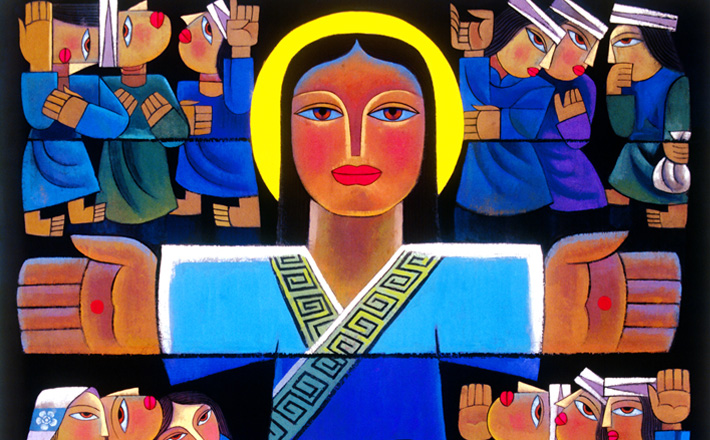Commentary on John 20:19-31
What is a disciple to do in the wake of Jesus’ resurrection?
Following the Easter story of Jesus’ appearance to Mary Magdalene, two parallel stories in John explore the responses of disciples to the message of his resurrection. Although Thomas is often singled out as deficient in belief, his story shares much in common with the response of the disciples as a whole. The twin accounts present the disciples as both believing and disbelieving. The gift of the Holy Spirit enlivens the disciples to continue Jesus’ ministry without rendering them perfect believers.
Thomas is missing when the other disciples encounter Jesus. Yet he hears from them the same proclamation they heard from Mary Magdalene: “We have seen the Lord!” (20:25; cf. 20:18). Like Thomas, the disciples were not immediately transformed by Mary’s proclamation of the good news. They remain behind locked doors, where they are gathered out of fear (20:19). Like Thomas, the disciples only respond with joy to Jesus’ presence after he shows them his hands and his side (20:20, 27). Although “doubting Thomas” gets his reputation from this story, his response of unbelief is not unique, but instead is typical of disciples of Jesus.
There are two theological issues at stake in the portrait of the disciples vis-á-vis Thomas. The first is the question of whether the disciples achieve perfect or complete belief following Jesus’ resurrection. Much of the language of the Farewell Discourse (John 14-17) has led readers to expect that it will. Jesus has spoken of a future time when the disciples would “know” (14:20), “testify” (15:27) and “do greater works” than Jesus has done (14:12). Although they manifest doubt during Jesus’ earthly life, the language of the Farewell Discourse suggests a future time when the disciples overcome these deficiencies. Many scholars read the resurrection stories as just such accounts, where the disciples’ belief is seen in its maturity.
However, the disciples are not presented simply as believers, even after Jesus’ resurrection. Even after his first appearance and the gift of the Holy Spirit (also foreseen in the Farewell Discourse (14:16-17), the disciples remain behind locked doors the second week as well (20:26). They proclaim the Easter message, “We have seen the Lord!” but their actions do not fully match their understanding. Although the narrator proclaims “blessed” the one who has not seen and yet has believed (20:29), this is true of none of Jesus’ disciples. Instead, John portrays the disciples as still reaching toward belief in Jesus.
Even Thomas’s confession, “My Lord and my God!” (20:28) does not mark the completion of his faith. His statement is a significant confession, but it is not the end of the story. In the next chapter, Thomas is named as one of seven disciples. The pattern is familiar: they initially do not recognize Jesus (21:4), but come to understand him (21:7). Yet they finish with a question about his identity that they dare not ask even as they know the answer (21:12). Although John’s language projects a future time in which disciples will understand Jesus, that perfect knowledge always lies outside the boundaries of the Gospel story. The disciples embody a belief that reaches toward but never quite achieves complete understanding of Jesus.
The second theological question these verses raise explicitly is the reader’s relationship to Jesus’ disciples. What is expected of later followers of Jesus, and should they understand themselves as like or unlike the disciples of the story? In verses 19-23, Jesus breathes the Holy Spirit onto the disciples. Is this a special possession of the early church? Some interpreters imagine “the disciples” here as a limited group of the twelve (minus Judas and Thomas) who are commissioned as official apostles with particular duties that raise them above the level of the average believer. Jesus’ words to them, “If you forgive the sins of any, they are forgiven them…” (20:23), reinforce the perception for many that the disciples have a unique role.
Yet it may be better to understand the disciples as a group that reflects John’s understanding of discipleship as a whole. As is often the case in John, “the disciples” who appear in 20:19 are unnumbered and unnamed. Although John clearly knows of the designation “the twelve,” he uses the phrase to identify disciples who are part of Jesus’ most intimate group of associates (6:71; 20:24) rather than to specify the actions or characteristics of the group.
Although readers may be primed to expect Jesus’ last supper to be eaten with the twelve (cf. Matt 26:20; Mark 14:11), or that he will appear to the eleven alone in his resurrection (Matt 28:16; Mark 16:14; Luke 24:33, 36), John specifies only that “the disciples” are present in each case (13:5; 20:19). This designation suggests a more open-ended group of people included in Jesus’ words and actions.
But what then does it mean for Jesus to breathe out the Holy Spirit and to tell this larger group of disciples, “If you forgive the sins of any, they are forgiven them”? The passage is a commissioning scene, but it is a commissioning of the church as a whole, not an elite group of leaders. John’s language seems to grant broad powers to the church to forgive or retain sins. It may help to remember that throughout John’s Gospel “sin” has referred to the rejection of Jesus and his ministry (e.g., 8:24; 9:41; 15:22-24). Jesus’ presence already reveals and condemns people’s belief or unbelief (cf. 3:17-19; 5:22). In Jesus’ absence the church steps into this role. The image is not a narrow one of a priest assigning penance but a broader recognition that the church becomes the arbiter of acceptance or rejection of Jesus.
Even so, part of our modern difficulty with this text may be that Jesus leaves this authority in the hands of disciples who are not themselves free from sin. John seems well aware of this, having positioned the story of commissioning in the midst of the disciples’ struggle to come to terms with their resurrection faith. Instead of trying to “solve” the problem of this responsibility granted to the church, I would say instead that the passage seems consistent with John’s portrait of the disciples. They are called to do much more than they are capable of. Yet they occasionally achieve great clarity, and in those moments they manifest the hope of the resurrection.


April 7, 2013